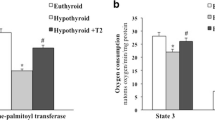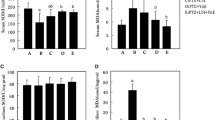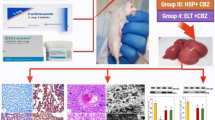Abstract
Recent data from animal studies suggest thatinduced hypothyroidism inhibits the development of liverinjury in several animal models, including livercirrhosis and fulminant hepatic failure in rats, and immune-mediated acute liver injury in mice. Theaim of the present study was to determine whetherhypothyroidism would likewise preventacetaminophen-induced hepatic damage in rats. Liverdamage was induced by acetaminophen (2 g/kg) administered bygavage to fasting rats as a single dose. Hypothyroidismwas induced by methimazole, propylthiouracil, orsurgical thyroidectomy and confirmed by elevated serum levels of TSH. Hypothyroidism significantlyinhibited acetaminophen-induced liver damage asmanifested by the decreased serum levels of liverenzymes, malondialdehyde and blood ammonia, as well asby the higher hepatic glutathione content, in allthree groups of hypothyroid rats compared to euthyroidcontrols (P < 0.01). Histopathologic analysis showedsignificantly less liver necrosis and inflammation in the acetaminophen-treated hypothyroid rats.Oxygen extraction, measured in isolated perfused ratliver preparation, was also reduced in the hypothyroidlivers to 42 ± 8% compared to 81 ± 14% ofcontrols (P < 0.01). However, the expression ofCYP2E1 in the livers of hypothyroid rats, as measured bywestern blot analysis, was not decreased compared tocontrol rats. These results suggest that inducedhypothyroidism, regardless of the mode of induction, protectsrat liver from acetaminophen hepatotoxicity. This effectmay be related to hypometabolism of liver cells, but theexact mechanism needs further clarification.
Similar content being viewed by others
REFERENCES
Orrego H, Blake JE, Blendis LM, Compton KV, Israel Y: Long-term treatment of alcoholic liver disease with propylthiouracil. N Engl J Med 317:1421–1427, 1987
Halle P, Pare P, Kaptein E, Kanel G, Redeker AG, Reynolds T: Double blind, controlled trial of propylthiouracil in patients with severe acute alcoholic hepatitis. Gastroenterology 82:925–931, 1982
Oren R, Hilzenrat N, Maaravi Y, Yaari A, Sikuler E: Hemodynamic effects of hypothyroidism induced by methimazole in normal and portal hypertensive rats. Dig Dis Sci 40:1941–1945, 1995
Oren R, Dotan I, Papa M, Maaravi Y, Aeed H, Barg J, Zaidel L, Bruck R, Halpern Z: Inhibition of experime ntally induced liver cirrhosis in rats by hypothyroidism. Hepatology 24:419–423, 1996
Bruck R, Oren R, Aeed H, Matas Z, Zaidel L, Halpern Z: Inhibition of fulminant hepatic failure in rats by hypothyroidism. Gastroenterology 110:A1159, 1996
Shirin H, Oren R, Dotan I, Papa M, Maaravi Y, Aeed H, Zaidel L, Matas Z, Bruck R, Halpern Z: Inhibition of concanavalin A-induced acute T cell dependent hepatic damage in mice by hypothyroidism. J Hepatol 23(1):213A, 1995
Davis M: Protective agents for ace taminophen overdose. Semin Liver Dis 6:138–147, 1986
Harrison PM, Keays R, Bray GP, Alexander GJM, Williams R: Improved outcome of paracetamol-induced fulminant hepatic failure by late administration of ace tylcysteine. Lancet 335:1572–1573, 1990
Mant TGK, Tempowski JH, Volans GN, Talbot JCC: Adverse reactions to ace tylcysteine and effects of overdose. Br Med J 289:217–219, 1984
Hissin PJ, Hilf R: A fluorome tric method for determination of oxidized and reduced glutathione in tissues. Anal Biochem 74:214–226, 1976
Corasanti JG, Smith ND, Gordon ER, Boyer JL: Protein kinase C agonists inhibit bile secretion independently of effects on the microcirculation in the isolated perfused rat liver. Hepatology 10:8–14, 1989
Kawasaki T, Carmichael FJ, Giles G, Saldivia V, Israel Y, Orrego H: Effects of propylthiouracil and methimazole on splanchnic hemodynamics in awake and unrestrained rats. Hepatology 10:273–278, 1989
Mitchell JR, Jollow DJ, Potter WZ, Davis DC, Gillete JR, Brodie BB: Ace taminophen-induced hepatic necrosis. I. Role of drug metabolism. J Pharmacol Exp Ther 187:185–194, 1973
Potter WZ, Davis DC, Mitchell JR, Jollow DJ, Gillete JR, Brodie BB: Acetaminophen-induced hepatic necrosis. III. Cytochrome P-450-mediated covale nt binding in vitro. J Pharmacol Exp Ther 187:203–210, 1973
Hinson JA, Pohl LR, Monks TJ, Gillete JR: Acetaminopheninduced hepatotoxicity. Life Sci 29:107–116, 1981
Mitchell JR, Jollow DJ, Potter WZ, Gillete JR, Brodie BB: Acetaminophen-induced hepatic necrosis. IV. Protective role of glutathione. J Pharmacol Exp Ther 187:211–217, 1973
Lauterburg BH, Mitchell JR: Toxic doses of acetaminophen suppress hepatic glutathione synthesis. Hepatology 2:8–12, 1982
Bernuau J, Benhamou JP: Fulminant and subfulminant liver failure. In Oxford Textbook of Clinical Hepatology, N McIntyre, JP Benhamou, J Bircher, M Rizzeto, J Rodes (eds). Oxford, Oxford University Press, 1991, p 942
Bismuth H, Samuel D, Gugenheim J, Castaing D, Bernuau J, Rueff B, Benhamou JP: Emerge ncy liver transplantation for fulminant hepatitis. Ann Intern Med 107:337–341, 1987
Blazka ME, Wilmer JL, Holladay SD, Wilson RE, Luster MI: Role of proin flammatory cytokines in ace taminophen hepatotoxicity. Toxicol Appl Pharmacol 133:43–52, 1995
Czaja MJ, Xu J, Alt A: Preve ntion of carbon tetrachlorideinduced liver injury by soluble tumor necrosis factor receptor. Gastroente rology 108:1849–1854, 1995
Simpson KJ, Lukacs N, Harrison DJ, Strieter RM, Kunkel SL: Parace tamol induced hepatic necrosis cannot be preve nted by tumor necrosis factor alpha inhibition. J Hepatol A158 (C14/06), 1997
Barve S, Hill D, McClain C: Acetaminophen hepatotoxicity: New insights. Gastroenterology 114:A1234, 1988
Park Y, Smith RD, Combs AB, Kehrer JP: Prevention of acetaminophen-induced hepatotoxicity by dimethylsulfoxide. Toxicology 52:165–175, 1988
Schwedes U, Wdowinski JM, Siede WH, Vardarli I, Schmidt R, Usadel KH: Effect of hypometabolism on ce ll injury. Klin Wochenschr 64(supplVII):146–14, 1986
Chieli E, Mavaldi G: Role of microsomal FAD-containing monooxigenase in the liver toxicity of thioacetamide S-oxide. Toxicology 31:41–52, 1984
Oinonen T, Lindros KO: Zonation of hepatic cytochrome P-450 expression and regulation. Biochemical J 329:17–35, 1988
Oinonen T, Mode A, Lobie PE, Lindros KO: Zonation of cytochrome P-450 expression in rat liver. Isozyme-specific regulation by pituitary dependent hormones. Biochem Pharmacol 51:1379–87, 1996
Gardner CR, Heck DE, Yang CS, Thomas PE, Zhang XJ, DeGeorge GL, Laskin JD, Laskin DL: Role of nitric oxide in acetaminophen-induced hepatotoxicity in the rat. Hepatology 26:748–754, 1998
Laskin DL, Pilaro AM: Potential role of macrophage s in acetaminophen hepatotoxicity. I. Isolation and characte rization of activated macrophages from rat liver. Toxicol Appl Pharmacol 86:204–215, 1986
Laskin DL, Pilaro AM, Ji S: Potential role of macrophage s in acetaminophen hepatotoxicity. II. Mechanism of macrophage accumulation and activation. Toxicol Appl Pharmacol 86:216–226, 1986
Carmichael FJ, Orrego H, Saldivia V, Israel Y: Effect of propylthiouracil on the ethanol-induced increase in liver oxygen consumption in awake rats. Hepatology 18:415–421, 1993
Romney JS, Chan J, Carr FE, Mooradin AD, Wong NCW: Identification of the thyroid hormone-responsive messe nger RNA spot 11 as apolipoprote in A1 me ssenge r RNA and effects of the hormone on the promotor. Mol Endocrinol 6(6):943–950, 1992
Rights and permissions
About this article
Cite this article
Bruck, R., Frenkel, D., Shirin, H. et al. Hypothyroidism Protects Rat Liver from Acetaminophen Hepatotoxicity. Dig Dis Sci 44, 1228–1235 (1999). https://doi.org/10.1023/A:1026652913347
Issue Date:
DOI: https://doi.org/10.1023/A:1026652913347




